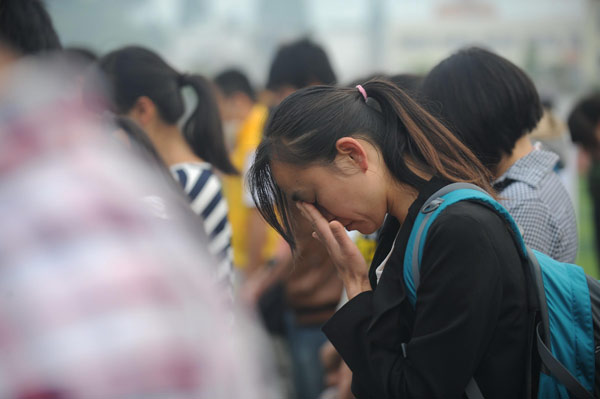 |
|
Students lower their heads during a silent tribute to the victims of Lushan April 20 earthquake, in Lushan Middle School, Ya'an city, Southwest China's Sichuan province on April 27, 2013. [Photo/Xinhua] |
|
After experiencing heavy casualties and extensive damage in powerful earthquakes since 2008, China is developing a way to give at least a few extra seconds' warning for those near quake epicenters. The system, called the National Earthquake Early Warning and Intensity Quick Reporting System, which will have an estimated cost of about 2 billion yuan ($324 million), is expected to be built before 2017 by the China Earthquake Administration — if the National Development and Reform Commission approves the project this year, the administration said. The administration said the system will detect earthquake-related shaking that are in the form of P-waves, which move rapidly but are harmless, and which arrive before the more-powerful and destructive shear waves, or S-waves. "As earthquakes cannot be predicted, getting people to safety quickly before the destructive waves arrive can largely decrease casualties," Li Shanyou, deputy director of the Institute of Engineering Mechanics under the China Earthquake Administration, told China Daily. He added that the few seconds of warning can also help a train driver slow down to avoid possible derailment, warn a doctor to stop a surgery, give a shutdown signal to chemical factories, prevent potential leaks and fires, and alert officials at critical projects, such as nuclear plants. Experts estimate that casualties could be reduced by 14 percent with a three-second advance warning of an earthquake, and 39 percent with a 10-second warning. The program includes the construction of more than 5,000 quake-monitoring stations across the country, guaranteeing every city above county level will have at least one. The system will be in four major areas — northern China, the north-south seismic belt, coastal regions of southeastern China, and northwestern Xinjiang Uygur autonomous region — with a station every 25 km. Li said if quake stations are about 30 km apart, the early-warning system can issue warning information about 10 seconds after a quake happens below ground. Detecting P-waves with the system can provide a few precious seconds to people before the powerful S-waves arrive. "The S-waves generally move at a speed of 3.5 km per second, which means before the warning is issued, S-waves have already spread in a radius of 35 km from the epicenter," he said, adding that the area within the 35-km radius of the epicenter, which is called the "blind area", cannot be warned. Lushan county in the Ya'an earthquake in Sichuan province was in the blind area, Li said. The early warning cannot play a role in small quakes, but if it is large with a huge affected area, the system will dramatically reduce damage and lead to fewer deaths, he said. |
4月20日,四川省雅安市芦山县发生7.0级地震,截至周四三已造成196人遇难;2010年4月14日,青海省玉树县发生7.1级地震,2,698人遇难;2008年5月12日,四川汶川发生8.0级强震,遇难和失踪人数达8.7万人。 面对如此频繁且震级较高的地震,建立“国家地震烈度速报与预警工程”已迫在眉睫。日前中国地震局工程力学研究所副所长李山有在接受《中国日报》专访时对该工程进行了详细的介绍。 “国家地震烈度速报与预警工程”是由覆盖全国的5000余个地震台站组成,工程完成后,不仅全国范围内每个县级以上城市都将布设1个或1个以上的地震台站,平均台站间距为40公里左右;而且华北地区、南北地震带、东南沿海地区及新疆西北部地区等四个区域将组成平均台站间距为25公里左右的地震观测台网,具备对破坏性地震的预警能力。 据悉该工程已于2012年12月正式进入国家发改委立项评估阶段,计划投入约20亿元,建设时间为5年。 李山有副所长还介绍了该工程的预警原理是利用地震产生的纵波(纵波传播速度快,能量小,一般不会造成破坏)和横波(横波速度相对较慢,但能量大,是造成地震破坏的主要原因)的传播时间差,在自动监测到纵波后快速估算地震参数,抢在横波传到某地前发出警报信息。这样可以为离开地震震中一定距离(预警盲区)的外围区域提供数秒至数十秒的预警时间。 公众利用这短暂但宝贵的时间可以因地制宜地采取避震或逃生措施;企业利用这短暂的时间可以提早采取应急处置措施,例如行驶中的高速列车可制动减速避免出轨翻车,输油气管线可关闭运行避免油气泄露引起污染或火灾,医院可中止精密手术(如眼科)避免操作事故,化工企业可紧急终止可能产生次生灾害操作等,核电厂等重大工程可提前进入应急状态避免次生灾害。 根据《西北地震学报》的报道统计,3秒的地震预警时间,伤亡减少率将达到14%;10秒,则可减少伤亡39%;20秒,可减少伤亡63%。 不过预警系统也有其自身的局限性。 李山有说如果地震台站的间距为30公里,预警系统进行数据等待和处理的时间大约为10秒,而破坏性地震横波以大约每秒3.5公里向外传播,10秒钟将覆盖半径为35公里的区域,而这个区域无法提供预警,称作预警盲区。 例如此次雅安地震,位于震中的芦山县就是预警盲区。 如果地震的震级不是很大,可能产生破坏的范围就处于盲区之内,此时再向预警盲区外的区域发布预警信息没有减灾意义。 但是,李山有介绍对于大地震来说,其破坏范围可能很大(如汶川地震有300多公里),可预警的潜在地震破坏区域也很大,距离震中越远,预警时间越长,减灾效果就越明显。 除了为地震外围区域提供预警,地震烈度速报与预警工程可以在震后数分钟后给出地震影响的程度和分布,为政府部门灾情判断、应急决策和救援力量调配等提供依据,为生命线工程的震后抢险恢复提供参考。 (中国日报记者 王茜 本文为编译,原文刊登于4月27日版《中国日报》) |